Germany
 Wars leave unfortunate consequences, one of the biggest being orphaned children. World War II is no exception to that rule. After the surrender of Germany, the nation was basically split into four sections…the American Zone, the Soviet Zone, the British Zone, and the French Zone. It was all part of the denazification process. The term denazification refers to the removal of the physical symbols of the Nazi regime. In 1957 the West German government re-issued World War II Iron Cross medals, among other decorations, without the swastika in the center. That was just one of the ways that the Nazi regime was removed from Germany.
Wars leave unfortunate consequences, one of the biggest being orphaned children. World War II is no exception to that rule. After the surrender of Germany, the nation was basically split into four sections…the American Zone, the Soviet Zone, the British Zone, and the French Zone. It was all part of the denazification process. The term denazification refers to the removal of the physical symbols of the Nazi regime. In 1957 the West German government re-issued World War II Iron Cross medals, among other decorations, without the swastika in the center. That was just one of the ways that the Nazi regime was removed from Germany.
Another way was the Denazified School System and the denazification of the rest of the German government…which was then reassembled without the Nazi symbolism. With the school system effectively out of commission, the children of Berlin had very little or even no structure in their lives at all. These were children whose lives had been shredded by the war, many of whom had been orphaned by the conflict or had lost at least one parent. That lead to an overall lack of adult supervisors. Children, and especially teens and preteens, roamed the streets in packs. The situation was especially difficult for the children who had lost both parents. There weren’t any real orphanages either, and so these children formed their own “families” on the streets…like street gangs. These children were known as German “wolf children” also known as “Wolfskinder,” but the reality was that they were simply the forgotten orphans of World War II.
The schools eventually reopened, but they were often in half-ruined facilities, that were underfunded and understaffed, with some schools reporting student-to-faculty ratios of 89 to 1. That kind of a classroom ratio is far too big to be able to effectively teach the students. And the re-opened schools didn’t really address the issue of these orphaned “wolf children” who were often in hiding whenever authorities were around. These children were most likely afraid of authority, because it was the authorities who got their parents killed in the first place. Many of these children were forced to flee what was then East Prussia to Lithuania at the end of World War II. They felt like the German government had failed them. These children survived hunger, cold, and the loss of their identity, and the German government had long overlooked them, so why would they trust the government now.
No one really knows just how many “wolf children” there were. That number can only be estimated. Some say there were up to 25,000 of them roaming the woods and swamps of East Prussia and Lithuania after 1945. Russians were actually forbidden from taking in these “fascist children.” These children were actually told to go to Lithuania and given the promise that there would be food there. When they arrived, they couldn’t speak the language and they had no papers, so they had no identity…no one could even know their names. Those who were taken in often had every shred of memorabilia from their past stripped from them and tossed in the trash. That was the last part of who they really were. It was the price they would pay for food, safety, and security; and it was a failure of the German government, and the four nations who were in charge of reorganizing Germany. I suppose some would disagree with me on that note, but the reality is plain to see. If these children came across kind locals, the “Vokietukai” or little Germans, in Lithuanian, as they were known, were helped with buckets of soup in front of the doors, giving the children a little nourishment. If the residents were not so kind, they would set their dogs on the children.
While the “Vokietukai” had many struggles in Lithuania, life was still better than the fate that awaited the 
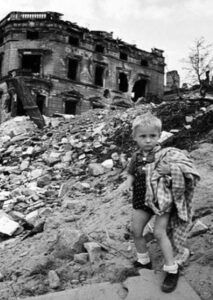 children who were too weak to make it to the Baltic states. There were thousands of these children, and they were sent to Soviet homes run by the military administration. That was the fate of approximately 4,700 German children in 1947, according to historian Ruth Leiserowitz, who has researched the fates of wolf children. Later that year, many of them were sent to the Soviet occupation zone. That zone later became the German Democratic Republic (GDR). Those poor children traveled in freight trains without any straw to sleep on…similar the Holocaust deportation years. These children were young…between 2 and 16 years of age. They arrived in East Germany after four days and four nights…really more dead than alive. There, they were put in orphanages or adopted by avid Communists. They never really escaped Communism…and that is the saddest part of all.
children who were too weak to make it to the Baltic states. There were thousands of these children, and they were sent to Soviet homes run by the military administration. That was the fate of approximately 4,700 German children in 1947, according to historian Ruth Leiserowitz, who has researched the fates of wolf children. Later that year, many of them were sent to the Soviet occupation zone. That zone later became the German Democratic Republic (GDR). Those poor children traveled in freight trains without any straw to sleep on…similar the Holocaust deportation years. These children were young…between 2 and 16 years of age. They arrived in East Germany after four days and four nights…really more dead than alive. There, they were put in orphanages or adopted by avid Communists. They never really escaped Communism…and that is the saddest part of all.
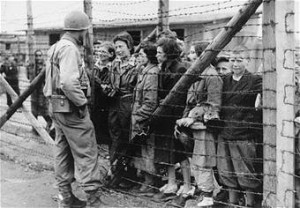 After years of being oppressed, starved, beaten, murdered, and used for experimentation, the Jewish people decided that it was their right to avenge their dead. The Nuremburg Trials were supposed to do all that, but so many of the Nazis had fled the country to escape the sentences they deserved, and once out of the country, it was almost impossible to get them back to face those sentences. In the late 1940s, under Juan Domingo Peron’s leadership (October 17, 1945 to July 1, 1974), the government secretly allowed entry of a number of war criminals fleeing Europe after Nazi Germany’s collapse, as part of the infamous ratlines. The number of Nazi fugitives that fled to Argentina surpassed 300, and included notorious war criminals such as Erich Priebke, Martin Bormann, Joseph Mengele, Eduard Roschmann, Josef Schwammberger, Walter Kutschmann, Otto Skorzeny and Holocaust administrator Adolf Eichmann, among others. In May 1960, Eichmann was kidnapped in Argentina by the Israeli Mossad and brought to trial in Israel. He was executed in 1962. At the time, Argentina condemned the Israeli government for abducting Eichmann, leading to a diplomatic spat between the nations.
After years of being oppressed, starved, beaten, murdered, and used for experimentation, the Jewish people decided that it was their right to avenge their dead. The Nuremburg Trials were supposed to do all that, but so many of the Nazis had fled the country to escape the sentences they deserved, and once out of the country, it was almost impossible to get them back to face those sentences. In the late 1940s, under Juan Domingo Peron’s leadership (October 17, 1945 to July 1, 1974), the government secretly allowed entry of a number of war criminals fleeing Europe after Nazi Germany’s collapse, as part of the infamous ratlines. The number of Nazi fugitives that fled to Argentina surpassed 300, and included notorious war criminals such as Erich Priebke, Martin Bormann, Joseph Mengele, Eduard Roschmann, Josef Schwammberger, Walter Kutschmann, Otto Skorzeny and Holocaust administrator Adolf Eichmann, among others. In May 1960, Eichmann was kidnapped in Argentina by the Israeli Mossad and brought to trial in Israel. He was executed in 1962. At the time, Argentina condemned the Israeli government for abducting Eichmann, leading to a diplomatic spat between the nations.
There was a financial incentive for Argentina to accept these war criminals, and they needed to provide a safe haven for them. Wealthy Germans and Argentine businessmen of German descent were willing to pay the way for escaping Nazis. The initial plan of the fleeing Nazis was to regroup, lay low for a while, and then come back with a vengeance. The Holocaust years had been very profitable for the Nazis. Nazi leaders had plundered untold millions from the Jews they murdered and some of that money accompanied them to Argentina…meaning the Argentine economy was helped by the war criminals…another incentive to help them hide out.
Some of the smarter Nazi officers and collaborators saw the writing on the wall as early as 1943 and began hiding gold, money, valuables, paintings, and more. They often moved their plunder to Switzerland. Ante Pavelic and his cabal of close advisors had several chests full of gold, jewelry, and art they had stolen from their Jewish and Serbian victims. These riches eased their passage to Argentina considerably. Disappearing, even in 1945 was not an easy matter, but if one had money, it was far more possible. The war criminals even paid off British officers to let them through Allied lines…a treasonous act for which those British officers should have 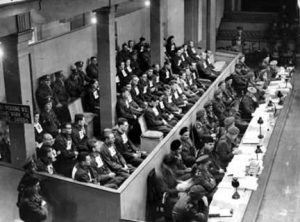 also been prosecuted and hung. Sometimes the corruption in government and military entities, even those who are supposed to be on the side of good, is absolutely astounding.
also been prosecuted and hung. Sometimes the corruption in government and military entities, even those who are supposed to be on the side of good, is absolutely astounding.
After the World War II, and the release of the surviving Jews, the Nuremburg Trials convicted these evil monsters, but many of them were gone before their sentence could be carried out. Enter the Nokmim, a group of Jewish men, also referred to as The Avengers or the Jewish Avengers. These men were a Jewish partisan militia, formed by Abba Kovner and his lieutenants Vitka Kempner and Rozka Korczak from the surviving remnants of the United Partisan Organization (Fareynikte Partizaner Organizatsye), which operated in Lithuania under Soviet command. Elements of the Nokmim collaborated with veterans of the Jewish brigade in British Palestine to form a new organization called Nakam, a group of assassins that targeted Nazi war criminals with the aim of avenging the Holocaust. The name comes from the phrase (Dam Yehudi Nakam – “Jewish Blood Will Be Avenged”) (the acronym DIN means “judgement”).
The Nakam (“vengeance”) Group was the most extremist group. They numbered around 60 Jews who were former Partisans, as well as other Jews who survived the Holocaust. This group was not about to let these men get away with all the atrocities they put their Jewish captives through, and then just walk away without punishment…not if they could help it. The group arrived in Germany after the war in order to conduct more complicated and fatal vengeance operations. Their ultimate purpose was to carry out an operation that would cause a broad international response…a warning, if you will, to anyone who might consider trying to harm Jews again, as the Nazis had. They needed to show the world that they would never be treated in such a way again. They would fight back…every time. Notables among the Hanakam group were Abba Kovner, Yitzhak Avidav, and Bezalel Michaeli. The group attempted a couple of mass poisonings, the first of the water supplies of Munich, Berlin, Weimar, Nuremberg and Hamburg, which failed when the poison had to be thrown overboard on a ship when Kovner was discovered to be carrying forges documents. The other attempt was with 3,000 loaves of bread painted with diluted arsenic, headed for 15,000 German POWs from the Langwasser internment camp near Nuremberg. The camp was under US authority. On April 23, 1946, it was reported that 2,283 German prisoners of war had fallen ill from poisoning, with 207 hospitalized and seriously ill. According to Harmatz, 300 to 400 Germans died. He said this “was nothing compared with what we really wanted to do.” A 2016 report by the Associated Press countered that the operation ultimately caused no known deaths, despite documents obtained through a Freedom of Information Act request to the National Archives and Records Administration 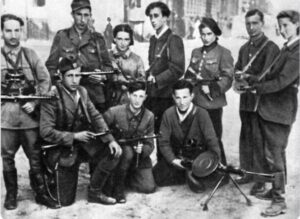 stating the arsenic found in the bakery was enough to kill approximately 60,000 persons. Apparently, the arsenic was spread too thin to be lethal.
stating the arsenic found in the bakery was enough to kill approximately 60,000 persons. Apparently, the arsenic was spread too thin to be lethal.
It’s hard to say just how much information is correct and how much is incorrect. I suppose it depends on who is reporting, and how accurately they want to report what they have. Propaganda in any war runs rampant, so we will likely never know. Records can and do go missing, especially when someone wants to disprove their enemies. Whether so many people died by poisoning or not, the Nokmim and the spin-off Nakam brought vengeance on many of the Nazis who would have escaped justice without them.
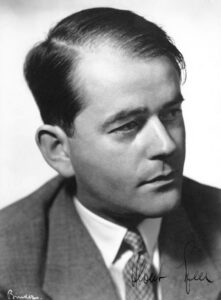 As Hitler continued his reign of terror over the people of Germany, in his quest to rule the world, he decided that he needed to destroy much of the German infrastructure so that the Allied forces couldn’t use it as they penetrated deep withing the borders of Germany. Hitler must have known by now that he was losing this war, even in his crazed state, so he was trying to find a way to turn the tide.
As Hitler continued his reign of terror over the people of Germany, in his quest to rule the world, he decided that he needed to destroy much of the German infrastructure so that the Allied forces couldn’t use it as they penetrated deep withing the borders of Germany. Hitler must have known by now that he was losing this war, even in his crazed state, so he was trying to find a way to turn the tide.
The Nero Decree (German: Nerobefehl) was the order issued by Hitler on March 19, 1945, right after the Allies captured the final bridge on the Rhine River that allowed access into Germany. The Nero Decree ordered the destruction of large numbers of bridges in Germany. The official name was Decree Concerning Demolitions in the Reich Territory (Befehl betreffend Zerstörungsmaßnahmen im Reichsgebiet), but that is rather a long name, so it became known as the Nero Decree, after the Roman Emperor Nero, who, according to an apocryphal story, “engineered the Great Fire of Rome in 64 AD.”

This act would have wiped out all of Germany’s industry and infrastructure just to keep it from falling under Allied control. Hitler didn’t care about that or about the people who would be affected. The actual task of carrying out such destruction fell to Germany’s armaments minister…and Hitler’s friend, Albert Speer. Speer knew that to follow the order would have a ruinous effect on the German people, so like Von Choltitz, who had disobeyed the order to burn Paris, Speer deliberately disobeyed the order of his friend, who he suspected was mentally unstable. In addition, Speer also issued encrypted alternate orders to delay the destruction. In the end, the Nero Decree wasn’t carried out at all, something which I’m quite certain drove Hitler totally insane.
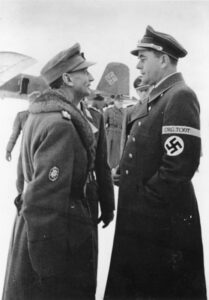
Speer was one of the highest-ranking members of German leadership to survive the war. He attempted to promote himself as someone who stood up to Hitler. While history does credit him with refusing to follow the Nero Decree, it did not completely exonerate him. Speer was an architect, and he wanted to preserve many buildings he had designed. Berthold Konrad Hermann Albert Speer, born March 19, 1905, in Mannheim, into an upper-middle-class family. He was the second of three sons of Luise Máthilde Wilhelmine (Hommel) and Albert Friedrich Speer. He was a German architect who served as the Minister of Armaments and War Production in Nazi Germany during most of World War II. He was also a close ally of Adolf Hitler, a relationship which would cause him to be convicted at the Nuremberg trials and sentenced to 20 years in prison. Speer returned to London in 1981 to participate in the BBC Newsnight program. He suffered a stroke and died in London on September 1, 1981.
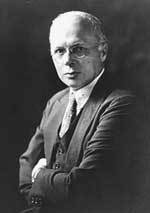 Modern medicine has come a long way through the advances of a number of people, one of the greatest being Richard Lewisohn. Born July 12, 1875, in Hamburg, Germany, Lewisohn studied medicine at the University of Freiburg, which is still one of the most prestigious medical schools in Europe. He obtained his medical degree in 1899, and in 1906, he immigrated to New York. Lewisohn’s initial interest was in the digestive system (gastroenterology). He began his work at Mount Sinai Hospital, but, it ended up being his work with blood transfusions that made him the medical hero he was.
Modern medicine has come a long way through the advances of a number of people, one of the greatest being Richard Lewisohn. Born July 12, 1875, in Hamburg, Germany, Lewisohn studied medicine at the University of Freiburg, which is still one of the most prestigious medical schools in Europe. He obtained his medical degree in 1899, and in 1906, he immigrated to New York. Lewisohn’s initial interest was in the digestive system (gastroenterology). He began his work at Mount Sinai Hospital, but, it ended up being his work with blood transfusions that made him the medical hero he was.
The blood is a complicated matter, and the study of the blood, or rather the experimentational use of the blood, often ended with tragic, and even fatal results. Of course, much of the problem came from having no understanding, or even any knowledge of blood types. The discovery of blood types didn’t come about until 1901, when Karl Landsteiner discovered that blood consisted of different types. Some types were compatible and could be transfused, leading to healing, but other types coagulated when mixed and would kill you. It was an amazing discovery, but Landsteiner’s discovery did not change medicine overnight. Doctors still faced the the fact that when blood was removed to transfuse into another person, it quickly clotted, making it unusable. That led to a direct method of transfusion, crazy in and of itself, in which doctors would sew the veins and arteries of the donor and the recipient together. Maybe it worked, but it just wasn’t practical. Not only did you have to have a donor with the correct type on hand, but the physician didn’t know how much blood was being pumped into the patient, or out  of the donor, for that matter. They needed a way to have blood on hand, and in measurable containers, all without having to deal with spoilage.
of the donor, for that matter. They needed a way to have blood on hand, and in measurable containers, all without having to deal with spoilage.
In April 1914, a Belgian physician named Albert Hustin, proved that sodium citrate could be used as an anticoagulant in diluted blood. Lewisohn immediately jumped upon this insight and set up detailed experiments using sodium citrate and dog blood. Through Lewisohn’s experiments transfusing dogs, he was able to determine the exact concentration of sodium citrate that was both safe and effective for blood transfusions. He was also able to keep the extracted blood viable for two days prior to transfusion. More study would eventually increase that timeframe up to 14 days.
This was exactly what the world needed…blood could be stored, and made available as needed. Lewisohn’s work led to the storage of blood in blood banks. It is a discovery that is credited with saving over 1 billion lives to date. Lewisohn’s discovery, occurring at the time of World War I, as well as his findings concerning blood storage for transfusions was used as a method to save the lives of wounded soldiers. Use of blood transfusions  expanded after the war. By the 1930s Blood Banks became common in cities worldwide, making blood transfusions the most important lifesaving medical advance in history.
expanded after the war. By the 1930s Blood Banks became common in cities worldwide, making blood transfusions the most important lifesaving medical advance in history.
In 1955 Lewisohn received the American Association of Blood Banks’ Karl Landsteiner Memorial Award. In January 1959 he became an honorary fellow of the Royal College of Surgeons of England, having been a fellow of the American College of Surgeons since 1916. Lewisohn was also a Fellow of the American Gastroenterological Association, and served on the American Board of Surgery. He passed away (probably of natural causes, but I cannot confirm that) on August 11, 1961 in New York City. He was 86 years old.
 On this day, August 21, 1911, an amateur painter decided to paint a painting near Leonardo da Vinci’s famed Mona Lisa, only to find out that someone had walked into the Louvre that morning, taken the priceless painting off the wall, hidden it under his clothing, and walked out of the museum. The first thought is, of course, who would be so brazen, but my second thought is how could he have pulled that off? How much clothing would it take to simply “tuck” a 20 inch by 30 inch painting into his clothing. Nevertheless, earlier that day, Vincenzo Perugia had walked into the Louvre, removed the famed painting from the wall, hid it beneath his clothes, and escaped.
On this day, August 21, 1911, an amateur painter decided to paint a painting near Leonardo da Vinci’s famed Mona Lisa, only to find out that someone had walked into the Louvre that morning, taken the priceless painting off the wall, hidden it under his clothing, and walked out of the museum. The first thought is, of course, who would be so brazen, but my second thought is how could he have pulled that off? How much clothing would it take to simply “tuck” a 20 inch by 30 inch painting into his clothing. Nevertheless, earlier that day, Vincenzo Perugia had walked into the Louvre, removed the famed painting from the wall, hid it beneath his clothes, and escaped.
The theft, somehow carried out in complete secrecy, left the entire nation of France is shock. There were many theories as to what could have happened to the priceless painting. Strangely, professional thieves were not on the list of suspects, because they would have realized that it would be too dangerous to try to sell the world’s most famous painting. I suppose that a private art collector might have hired a professional to steal it for a secret collection, but that didn’t seem to be the case. One theory, or  rumor really, in Paris was that the Germans had stolen it to humiliate the French. I’m not sure that made any sense before either of the world wars, but I guess tensions between the nations could have been on the rise then.
rumor really, in Paris was that the Germans had stolen it to humiliate the French. I’m not sure that made any sense before either of the world wars, but I guess tensions between the nations could have been on the rise then.
For two years, investigators and detectives searched for the painting without finding any real leads. Then in November 1913, the thief mad his first move…the one that would eventually bring his doom. Italian art dealer Alfredo Geri received a letter from a man calling himself Leonardo. It indicated that the Mona Lisa was in Florence and would be returned for a hefty ransom. Why he waited two years to ask for a ransom is beyond me, other than the fear of getting caught. The meet was set to pay the ransom, and when Perugia attempted to receive the ransom, he was captured. The painting was recovered, unharmed.
In a way, you could say that this was an inside job. Perugia knew his way around, and knew areas where the  Louvre might be vulnerable. Perugia, a former employee of the Louvre, claimed that he had acted out of a patriotic duty to avenge Italy on behalf of Napoleon. That claim was disproven when prior robbery convictions and Perugia’s diary, with a list of art collectors, caused most people to believe that he had acted solely out of greed. Perugia served seven months of a one-year sentence and later served in the Italian army during the First World War. The Mona Lisa is back in the Louvre, where improved security measures are now in place to protect it. I guess that one good thing came of the theft…better security. Of course, that might have come with technological advances anyway.
Louvre might be vulnerable. Perugia, a former employee of the Louvre, claimed that he had acted out of a patriotic duty to avenge Italy on behalf of Napoleon. That claim was disproven when prior robbery convictions and Perugia’s diary, with a list of art collectors, caused most people to believe that he had acted solely out of greed. Perugia served seven months of a one-year sentence and later served in the Italian army during the First World War. The Mona Lisa is back in the Louvre, where improved security measures are now in place to protect it. I guess that one good thing came of the theft…better security. Of course, that might have come with technological advances anyway.
 Some nations really can’t be trusted with weapons of mass destruction. They are eager to start a war, and they don’t have the moral scruples necessary to care about the loss of life involved. When nuclear weapons began to be produced, nations like the Soviet Union, China, Germany, Iran, Iraq, and various others, simply couldn’t be trusted with these weapons, but it was difficult to stop them from developing them, just like it is today. Therefore, nations have had to develop ways to restrict the usage of these weapons.
Some nations really can’t be trusted with weapons of mass destruction. They are eager to start a war, and they don’t have the moral scruples necessary to care about the loss of life involved. When nuclear weapons began to be produced, nations like the Soviet Union, China, Germany, Iran, Iraq, and various others, simply couldn’t be trusted with these weapons, but it was difficult to stop them from developing them, just like it is today. Therefore, nations have had to develop ways to restrict the usage of these weapons.
On July 21, 1955, President Dwight D Eisenhower presented his “Open Skies” plan at the 1955 Geneva summit meeting with Prime Minister Anthony Eden of Great Britain, Premier Edgar Faure of France, and Premier Nikolai Bulganin of the Soviet Union…acting for Soviet leader Nikita Khrushchev, in Geneva in July 1955, to present the plan. The plan was never accepted, but it laid the foundation for President Ronald Reagan’s “Trust, But Verify” policy in relation to arms agreements with the Soviet Union. The planned agenda for the summit included discussions on the future of Germany and arms control, but as it became clear that no agreement could be  reached on the issue of possible German reunification or the precise configuration of an arms control agreement, considering what had happened in Germany after World War I, Eisenhower dramatically unveiled what came to be known as his “Open Skies” proposal. The proposal called for the United States and the Soviet Union to exchange maps indicating the exact location of every military installation in their respective nations. The purpose of the maps was to allow each nation to conduct aerial surveillance of the installations in order to assure that the other nations were in compliance with any arms control agreements that might be reached. While it sounded like a good idea, it had little chance of acceptance. The French and British expressed interest in the idea, but the Soviets rejected any plan that would leave their nation subject to surveillance by a Western power. Khrushchev declared that Eisenhower’s “Open Skies” was nothing more than an “espionage plot.”
reached on the issue of possible German reunification or the precise configuration of an arms control agreement, considering what had happened in Germany after World War I, Eisenhower dramatically unveiled what came to be known as his “Open Skies” proposal. The proposal called for the United States and the Soviet Union to exchange maps indicating the exact location of every military installation in their respective nations. The purpose of the maps was to allow each nation to conduct aerial surveillance of the installations in order to assure that the other nations were in compliance with any arms control agreements that might be reached. While it sounded like a good idea, it had little chance of acceptance. The French and British expressed interest in the idea, but the Soviets rejected any plan that would leave their nation subject to surveillance by a Western power. Khrushchev declared that Eisenhower’s “Open Skies” was nothing more than an “espionage plot.”
The truth is that “Open Skies” was definitely not an “espionage plot,” but then we all knew that. Eisenhower was later quoted as saying that he knew “the Soviets would never accept the plan, but thought that their rejection of the idea would make the Russians look like they were the major impediment to an arms control  agreement.” The problem the Soviets had was that US surveillance planes would quickly find out that the Soviet Union was far behind the United States in terms of its military capabilities. The United States soon found that out anyway, because just a few months after the Soviet rejection of “Open Skies,” the Eisenhower administration approved the use of high-altitude spy planes (the famous U-2s) for spying on the Soviet Union. Thirty years later, President Reagan would use much the same rhetoric in his arms control dealings with the Soviet Union. Arms control, he declared, could only be effective if compliance with such agreements could be verified. “Trust, but verify” became Reagan’s standard phrase, and the truth is they were both right. If these rogue nations can’t be held accountable, they will continue to develop weapons of mass destruction, even while they are in a supposed agreement not to.
agreement.” The problem the Soviets had was that US surveillance planes would quickly find out that the Soviet Union was far behind the United States in terms of its military capabilities. The United States soon found that out anyway, because just a few months after the Soviet rejection of “Open Skies,” the Eisenhower administration approved the use of high-altitude spy planes (the famous U-2s) for spying on the Soviet Union. Thirty years later, President Reagan would use much the same rhetoric in his arms control dealings with the Soviet Union. Arms control, he declared, could only be effective if compliance with such agreements could be verified. “Trust, but verify” became Reagan’s standard phrase, and the truth is they were both right. If these rogue nations can’t be held accountable, they will continue to develop weapons of mass destruction, even while they are in a supposed agreement not to.
 How could a food become a problem in a war? I mean its something you eat, not fight with. Nevertheless, during World War I, the Germans were so hated and the Third Reich was so evil, that no one among the Allies wanted anything to do with them. They didn’t even want to be associated with anything that even remotely sounded like it was German. With that in mind, the word “hamburger” came to mind. It was decided that the “hamburger” was just a little too German to be allowed to continue being served with that name. You might think that people would get mad about that, but the people were very loyal to our nation and to the cause. They couldn’t tolerate the horrific crimes against humanity they saw in front of themselves. The Germans made it very clear to the world that they were, at least will Hitler was in charge, the most horrific nation on Earth.
How could a food become a problem in a war? I mean its something you eat, not fight with. Nevertheless, during World War I, the Germans were so hated and the Third Reich was so evil, that no one among the Allies wanted anything to do with them. They didn’t even want to be associated with anything that even remotely sounded like it was German. With that in mind, the word “hamburger” came to mind. It was decided that the “hamburger” was just a little too German to be allowed to continue being served with that name. You might think that people would get mad about that, but the people were very loyal to our nation and to the cause. They couldn’t tolerate the horrific crimes against humanity they saw in front of themselves. The Germans made it very clear to the world that they were, at least will Hitler was in charge, the most horrific nation on Earth.
Because of the conflict between Germany and the rest of the world, menus were changed to purge the names of German foods from restaurant menus. The name sauerkraut became “liberty cabbage,” and hamburgers became “liberty steaks.” Frankfurters, a very German name, was also deemed unacceptable during World War I, and in some places the name was switched to “liberty sausages,” but that was one new name that didn’t quite stick…especially when someone tried the term “hot dog.” It seems almost laughable now, because why should food play such a big part in the feelings of people, but then again, in this day and age, we are facing a situation that is much the same…the current “war” against China, Italy, and Germany (once again). This war may not be one  of dropping bombs and killing people, but it is a war nevertheless…and it is just as dangerous, if not more so.
of dropping bombs and killing people, but it is a war nevertheless…and it is just as dangerous, if not more so.
After World War II, and after the disdain against the Germans faded, the hamburger reemerged. During that time, the invention claims also emerged. It is thought that the hamburger was invented between 1885 and 1904, but it is clearly the product of the early 20th century. The origin is under dispute. Some say it was invented in the United States and some say that it was invented in Germany. During the following 100 years, the hamburger spread throughout the world, and continued on until World War I when it became just a little too German.
 Sometimes, in researching weapons of war, and especially during World War II, I am shocked and horribly saddened by the ability of man to impose new and horrific means of death upon their enemies…simply because they disagree about how things should be run. During World War II, and possibly earlier, the killing method of Carpet bombing, also known as saturation bombing, came into practice. Carpet bombing is just what you would expect, “a large area bombardment done in a progressive manner to inflict damage in every part of a selected area of land.” Instantly, a picture of multiple explosions, the destruction of large areas of a town, or the entire town, come to mind. Mass casualties are expected. This is the way war is waged when hate reigns, but then most wars these days or even in the World War II era were filled with hate.
Sometimes, in researching weapons of war, and especially during World War II, I am shocked and horribly saddened by the ability of man to impose new and horrific means of death upon their enemies…simply because they disagree about how things should be run. During World War II, and possibly earlier, the killing method of Carpet bombing, also known as saturation bombing, came into practice. Carpet bombing is just what you would expect, “a large area bombardment done in a progressive manner to inflict damage in every part of a selected area of land.” Instantly, a picture of multiple explosions, the destruction of large areas of a town, or the entire town, come to mind. Mass casualties are expected. This is the way war is waged when hate reigns, but then most wars these days or even in the World War II era were filled with hate.
In the European Theatre, the first city to suffer heavily from aerial bombardment was Warsaw, on September 25, 1939. Achieving the results they wanted, the Germans continued this trend in warfare with the Rotterdam Blitz…an aerial bombardment of Rotterdam by 90 bombers of the German Air Force on May 14, 1940, during the German invasion of the Netherlands. The objective was to support the German assault on the city, break Dutch resistance, and force the Dutch to surrender. So in the middle of a ceasefire, they dropped the bombs anyway, destroying almost the entire historic city center, killing nearly nine hundred civilians and leaving 30,000 people homeless. That was still not enough for the Nazis. The Oberkommando der Luftwaffe (OKL) used the destructive success of the bombing to threaten to destroy the city of Utrecht, if the Dutch government did not surrender. The Dutch surrendered early the next morning.
With the actions of the Nazis, the British knew that they had to act. The Battle of Britain developed from a fight for air supremacy into the strategic and aerial bombing of London, Coventry and other British cities. The British built up the RAF Bomber Command in retaliation for the bombings, which was capable of delivering many thousands of tons of bombs onto a single target, in spite of heavy initial bomber casualties in 1940. The plan was to break German morale and obtain the surrender which Douhet had predicted 15 years earlier. Then the  United States joined the war and the USAAF greatly reinforced the campaign, bringing in the Eighth Air Force into the European Theatre.
United States joined the war and the USAAF greatly reinforced the campaign, bringing in the Eighth Air Force into the European Theatre.
Still, that meant that the Allies would have to play the same game the Nazis had played. Many cities, both large and small, were virtually destroyed by Allied bombing. Cologne, Berlin, Hamburg and Dresden are among the most infamous, the latter two developing firestorms. I suppose the Germans finally found out what their own horrific tactics had done. Carpet bombing was also used as close air support (as “flying artillery”) for ground operations. The massive bombing was concentrated in a narrow and shallow area of the front (a few kilometers by a few hundred meters deep), closely coordinated with the advance of friendly troops. The first successful use of the technique was on May 6, 1943, at the end of the Tunisia Campaign. Carried out under Sir Arthur Tedder, it was hailed by the press as Tedder’s bomb-carpet (or Tedder’s carpet). The bombing was concentrated in a four by three-mile area, preparing the way for the First Army. This tactic was later used in many cases in the Normandy Campaign.
Carpet bombing was used extensively against Japanese civilian population centers, such as Tokyo, in the Pacific War. On the night of March, 9-10, 1945, 334 B-29 Superfortress heavy bombers were directed to attack the most heavily populated civilian sectors of Tokyo. Over 100,000 people burned to death in just one night from a heavy bombardment of incendiary bombs, comparable to the wartime number of US casualties in the entire Pacific theater. Another 100,000 to one million Japanese were left homeless. Similar attacks against Kobe, Osaka, and Nagoya, as well as other sectors of Tokyo followed, where over 9,373 tons of incendiary bombs were dropped on civilian and military targets. By the time of the dropping of the atomic bombs on Hiroshima and Nagasaki, light and medium bombers were being directed to bomb targets of convenience, because most urban areas had already been destroyed. In the 9-month long civilian bombing campaign, over 400,000 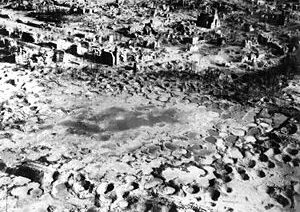 Japanese civilians died.
Japanese civilians died.
Carpet bombing of cities, towns, villages, or other areas containing a concentration of civilians is considered a war crime as of Article 51 of the 1977 Protocol I of the Geneva Conventions. Sometimes, that might make the nations think twice, but some nations, like the German Third Reich, think they can get away with anything. Hitler was crazy, and after deciding on the “Final Solution,” what is a little bit of Carpet Bombing in the mix. Carpet bombing was a horrible use of force, and in World War II and other wars since, it has taken many lives, and in the wrong hands it’s even worse.
 During World War II, there were hundreds of thousands, if not millions, of bombs dropped across Europe. There is no way to know where they were dropped, or if they actually exploded, or worse yet, if they are still lurking beneath the surface waiting to detonate. Princess Diana was a champion of a similar cause, but she was concerned about landmines…just as deadly, but a different deployment. Both concerns are real, and both situations are deadly. One German bomb specialist said that the problem will haunt Europe for centuries, saying, “There will still be bombs 200 years from now.”
During World War II, there were hundreds of thousands, if not millions, of bombs dropped across Europe. There is no way to know where they were dropped, or if they actually exploded, or worse yet, if they are still lurking beneath the surface waiting to detonate. Princess Diana was a champion of a similar cause, but she was concerned about landmines…just as deadly, but a different deployment. Both concerns are real, and both situations are deadly. One German bomb specialist said that the problem will haunt Europe for centuries, saying, “There will still be bombs 200 years from now.”
One such example is that of the German town of Limberg, whose residents woke up to a startling sight on the morning of June 23, 2019. A crater in a field as large as a house. The explosion was caused by a leftover bomb from World War II. Unexploded bombs really are a huge problem in Germany and other European countries, because these long-buried weapons periodically surface or spontaneously explode. No one knows when it might happen and the aftermath can be devastating. The explosion occurred in the central German town of Ahlbach, just north of Frankfurt. Residents reported hearing and feeling a large explosion in the early morning hours of Sunday the 23rd, but no one actually saw the explosion occur. During a follow-up the next day, they found a crater 33 feet wide and 14 feet deep in the middle of a barley field. It was determined that a decomposing bomb detonator for the explosion.
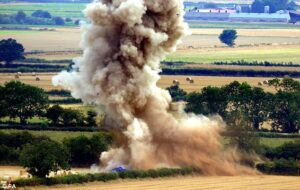
According to the BBC, “explosive ordnance demolition teams concluded that the explosive device was a 551 pound aerial bomb dropped by the Allies during World War II. The bomb was likely a M43, AN-M43, or AN-M64 500 pound general purpose bomb. General purpose bombs at terminal velocity will penetrate 3-4 building stories before detonating, so it’s not surprising this bomb buried itself so well.”
“The M65 was five feet long and 14 inches wide, and carried a payload of 280 pounds of TNT. The bomb casing, designed to produce fragment into lethal shrapnel, was .3 inches thick. An explosive ordnance disposal guidebook describes their purpose as to destroy ‘steel railway bridges, underground railways, sea craft such as light cruisers, concrete docks, medium sized buildings, etc.’”
During World War II, Germany operated several facilities in areas important to the war effort, including Limburg Field and an important railroad junction and marshaling yard. Allied bombs were dropped during the war, but often missed by miles. Falling at a high rate of speed, that morning’s bomb buried itself in the soft soil and 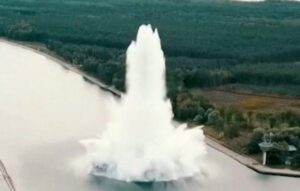 remained undetected for decades. Whoever cultivated the barley field obviously had no idea 280 pounds of highly unstable explosives lurked underneath, and thankfully no one was hurt
remained undetected for decades. Whoever cultivated the barley field obviously had no idea 280 pounds of highly unstable explosives lurked underneath, and thankfully no one was hurt
Seventy five years after the end of World War II, unexploded bombs are still a huge problem not only in Germany, but across all of Europe. The explosions don’t happen often, but when one explodes the results can be devastating. Governments are trying to find these bombs. Experts drill holes and look for bombs using magnetometers, searching for the signature of a bomb’s steel casing. Then they defuse or explode them harmlessly.

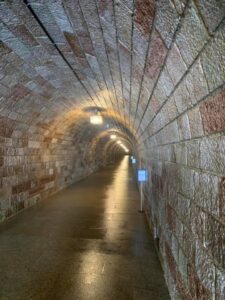 A few days ago, my friends, Rikki and Tony Ramsey (who is stationed in Germany) and their three sons, Jameson, Jackson, and Jordan posted some pictures of a trip they took to Salzburg, Austria. On the way there, they went to a place in the mountains, and posted pictures of them in front of a large cross. It was the cross that caught my eye, but the story of the place that held my interest. In English the place is called the Eagle’s Nest, but in German it is the Kehlsteinhaus and it is a building and cross erected by the Third Reich atop the summit of the Kehlstein, a rocky outcrop that rises above Obersalzberg near the town of Berchtesgaden. This was not a church or a fancy mountain-top resort or restaurant…at least not then. It was used exclusively by members of the Nazi Party for government and social meetings, and was visited on 14 documented instances by Adolf Hitler, who disliked the location due to his fear of heights, the risk of bad weather, and the thin mountain air. Today, the building is owned by a charitable trust and is open seasonally to the public as a restaurant, beer garden, and tourist site. I’m sure Hitler would be furious about that.
A few days ago, my friends, Rikki and Tony Ramsey (who is stationed in Germany) and their three sons, Jameson, Jackson, and Jordan posted some pictures of a trip they took to Salzburg, Austria. On the way there, they went to a place in the mountains, and posted pictures of them in front of a large cross. It was the cross that caught my eye, but the story of the place that held my interest. In English the place is called the Eagle’s Nest, but in German it is the Kehlsteinhaus and it is a building and cross erected by the Third Reich atop the summit of the Kehlstein, a rocky outcrop that rises above Obersalzberg near the town of Berchtesgaden. This was not a church or a fancy mountain-top resort or restaurant…at least not then. It was used exclusively by members of the Nazi Party for government and social meetings, and was visited on 14 documented instances by Adolf Hitler, who disliked the location due to his fear of heights, the risk of bad weather, and the thin mountain air. Today, the building is owned by a charitable trust and is open seasonally to the public as a restaurant, beer garden, and tourist site. I’m sure Hitler would be furious about that.
The Kehlsteinhaus is located on a ridge atop the Kehlstein, a 6,017 feet subpeak of the Hoher Göll that rises above the town of Berchtesgaden. It construction was commissioned by Martin Bormann in the summer of 1937, and paid for by the Nazi Party. It took 13 months to complete, and whether is was the speed of its construction, or simply poor safety standards, twelve workers died during its construction. The road to Kehlsteinhaus is 13 feet wide and climbs 2,600 feet over 4 miles. To get to Kehlsteinhaus, the road goes through five tunnels and one hairpin turn. The road cost RM 30 million to build (about €150 million inflation-adjusted for 2007), which equals about 180,450,000 US dollars. Hitler’s birthday in April 1939 was considered a deadline for the project’s completion, so work continued throughout the winter of 1938, even at night with the worksite lit by searchlights. That explains the twelve deaths, I suppose.
Once you arrive, there is a large car park. From there, a 407 feet entry tunnel leads to an ornate elevator that ascends the final 407 feet to the building. Even the tunnel was elaborate. It was lined with marble and was originally heated, with warm air from an adjoining service tunnel. Most people walked into the elevator, but visiting high-officials were commonly driven through the tunnel to the elevator. Since the tunnel was to narrow to turn around, the driver then had to reverse the car for the entire length of the tunnel. The elevator was elaborate too, of course. The inside was surfaced with polished brass, Venetian mirrors, and green leather. The building’s main reception room is dominated by a fireplace of red Italian marble presented by Italian dictator Benito Mussolini, which was damaged by Allied soldiers chipping off pieces to take home as souvenirs. Hitler had the best of everything in the building. Unusual for 1937, the building had a completely electric appliance 
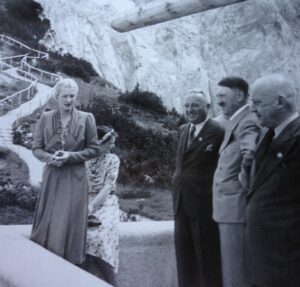 kitchen, but it was never used to cook meals…instead meals were prepared in town and taken to the kitchen on the mountain top to be reheated. Another extravagancy was the heated floors, with heating required for at least two days before visitors arrived. A MAN submarine diesel engine and an electrical generator were installed in an underground chamber close to the main entrance, to provide back-up power. Much of the furniture was designed by Paul László.
kitchen, but it was never used to cook meals…instead meals were prepared in town and taken to the kitchen on the mountain top to be reheated. Another extravagancy was the heated floors, with heating required for at least two days before visitors arrived. A MAN submarine diesel engine and an electrical generator were installed in an underground chamber close to the main entrance, to provide back-up power. Much of the furniture was designed by Paul László.
Hitler first visited on September 16, 1938, and returned to inaugurate it on April 20, 1939, his 50th birthday…though supposedly, it was not intended as a birthday gift. There are two ways to approach and enter the building…the road and the Kehlsteinhaus elevator. Hitler did not trust the elevator, continually expressed his reservations of its safety, and disliked using it. His biggest fear was that the elevator’s winch mechanism on the roof would attract a lightning strike. Bormann took great pains to never mention the two serious lightning strikes that occurred during construction. For a man who was supposedly such a “brave leader,” Hitler sure was afraid of a lot of things. The Kehlsteinhaus lies several miles directly above the Berghof, Hitler’s summer home. In a rare diplomatic engagement, Hitler received departing French ambassador André François-Poncet on October 18, 1938, there. It was he who actually came up with the name “Eagle’s Nest” for the building while later describing the visit. Since then, the name has remained. A wedding reception for Eva Braun’s sister Gretl was held there following her marriage to Hermann Fegelein on June 3, 1944. While Hitler more often than not left the entertaining duties to others, he believed the house presented an excellent opportunity to entertain important and impressionable guests. Often referred to as the “D-Haus,” short for “Diplomatic Reception House,” the Kehlsteinhaus is often combined with the teahouse on Mooslahnerkopf Hill near the Berghof, which Hitler walked to daily after lunch. Later, after the war, the teahouse was demolished by the Bavarian government, due to its connection to Hitler.
The Allies tried to bomb the Kehlsteinhaus in the April 25, 1945 Bombing of Obersalzberg, but the little house did not make an easy target for the force of 359 Avro Lancasters and 16 de Havilland Mosquitoes, which were sent to bomb Kehlsteinhaus, but instead, severely damaged the Berghof area. Undamaged in the April 25 bombing raid, the Kehlsteinhaus was subsequently used by the Allies as a military command post until 1960, when it was handed back to the State of Bavaria. The road to the Kehlsteinhaus has been closed to private vehicles since 1952 because it is too dangerous, but the house can be reached on foot (in two hours) from Obersalzberg, or by bus from the Documentation Center there. The Documentation Centre currently directs visitors to the coach station where tickets are purchased. The buses have special modifications to take on a 
 slight angle, as the steep road leading to the peak is too steep for regular vehicles. The Kehlsteinhaus itself does not mention much about its past, except in the photos displayed and described along the wall of the sun terrace that documents its pre-construction condition until now. The lower rooms of the structure are not part of the restaurant but can be visited with a guide. They offer views of the building’s past through plate-glass windows, including graffiti left by Allied troops that is still visible in the surrounding woodwork. The red Italian marble fireplace remains damaged by Allied souvenir hunters, though this was later halted by signage posted that the building was US government property, and damage to it was cause for disciplinary action. Hitler’s small study is now a storeroom for the cafeteria. Thanks to the Ramsey family for taking us along.
slight angle, as the steep road leading to the peak is too steep for regular vehicles. The Kehlsteinhaus itself does not mention much about its past, except in the photos displayed and described along the wall of the sun terrace that documents its pre-construction condition until now. The lower rooms of the structure are not part of the restaurant but can be visited with a guide. They offer views of the building’s past through plate-glass windows, including graffiti left by Allied troops that is still visible in the surrounding woodwork. The red Italian marble fireplace remains damaged by Allied souvenir hunters, though this was later halted by signage posted that the building was US government property, and damage to it was cause for disciplinary action. Hitler’s small study is now a storeroom for the cafeteria. Thanks to the Ramsey family for taking us along.

